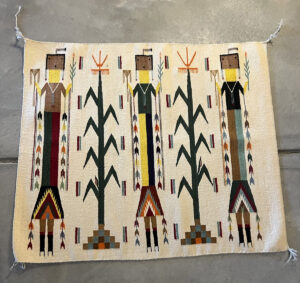 What are the value characteristics of Native American rugs? The most salient value is the profound symbolism in each rug, the meaning the rugs traditionally carry for the People. Since the early 20th century Tribal rugs became available through regional Southwest trading posts which dealt directly with Native artists. MM’s parents from Colorado collected two such rugs in the second or third quarter of the 20th century. They appear in wonderful shape, a testimony to the strength of the weaving techniques. Characteristics of this pair of fine Navajo rugs apply to many other Native American rugs. Many clients don’t want dollar values of their rugs, they want to repatriate them to the People or a dedicated museum, a worthy tax deductible, gift indeed.
What are the value characteristics of Native American rugs? The most salient value is the profound symbolism in each rug, the meaning the rugs traditionally carry for the People. Since the early 20th century Tribal rugs became available through regional Southwest trading posts which dealt directly with Native artists. MM’s parents from Colorado collected two such rugs in the second or third quarter of the 20th century. They appear in wonderful shape, a testimony to the strength of the weaving techniques. Characteristics of this pair of fine Navajo rugs apply to many other Native American rugs. Many clients don’t want dollar values of their rugs, they want to repatriate them to the People or a dedicated museum, a worthy tax deductible, gift indeed.
The tradition of textiles that ‘tell stories’ through symbolic design goes back centuries. Navajo (the Dine) weavers work in this tradition today. Although rugs pre-1925 are prized, modern rugs are prized as modern works of art, honoring the ancient techniques of natural materials and natural dyes. Collectors prefer dyes made from plants, indigo, or minerals, over artificially produced chemical dyes (aniline).
Aniline Vs Naturally Dyed Wool Rugs
Softer, less edgy hue in colors found in nature likely indicates naturally dyed wool. Fading over the years, aging gracefully, offers a good sign. Aniline dyed wool lacks subtlety, may ‘vibrate’ with an intense tone, and will resist fading. Yet, the color palette on these naturally dyed rugs appear arresting. Pre-1920s rugs tend to sport strong geometric patterns, so complex people call them an “eye dazzler.”
Prized rugs are hand-woven on vertical looms, where the vertical wool (the warp) is a single continuous thread, creating durability. The horizontal wool thread (the weft) carries the pattern, the story told by the rug. Many myths come with variations on a traditional “story.” One of MM’s rugs is such a narrative, the “storm” pattern, celebrating the moment when the skies open up, lightning strikes, thunder crashes. Without rain, the People don’t thrive.
Traditionally, the textiles, woven like flat tapestry, functioned as blankets. Larger blankets, from the mid to late 19th century, especially oversized “chief’s” blankets, are extremely valuable. As the art entered the 20th century, a newer category of form came about, the floor rug, made for tourist consumption. Areas in the American Southwest offered bespoke trading posts.
MM’s Valuation Factors
MM’s rug with the “storm” pattern indicates an origination from the Teec Nos Pos area in Northeastern Arizona. The name in Navajo means “circle of trees.” A strong geometric style, see the four corners for the lightning bolts and spikes. The two central medallions picked out in red, cream, and black, symbolize rain clouds, jagged lines thunder claps. The hooked triangular devices are the visual “sounds” of the thunderstorm, meandering pattern of the border is the repetition of the rain. This style became popular among Navajo artists in the 1920s. This one seems large for its genre at seventy-one by forty-four inches. Hand-spun wool is finely woven, and the beige indicates the use of natural dyes. Because of these valuation factors, it’s worth $3,000 or more. MM doesn’t want to sell because of his great respect for the tradition.
 The next rug shows traditional Yei figures, guardians of the corn. Full body frontal figures hold small corn plants and shovels, opposed to the traditional bow and arrow. The pattern was born from Navajo sand paintings interpreted by weaver Hosteen Klah (1867-1937). Rugs dating to the period of 1930-40 are most valuable. These Yei Bei Chai figures are female with rectangular heads, benevolent, supernatural beings, protectors, messengers between the Navajo people and the gods.
The next rug shows traditional Yei figures, guardians of the corn. Full body frontal figures hold small corn plants and shovels, opposed to the traditional bow and arrow. The pattern was born from Navajo sand paintings interpreted by weaver Hosteen Klah (1867-1937). Rugs dating to the period of 1930-40 are most valuable. These Yei Bei Chai figures are female with rectangular heads, benevolent, supernatural beings, protectors, messengers between the Navajo people and the gods.
A further manifestation, not seen on MM’s rug, which made the rug more valuable, is the Rainbow Guardian, symbolized in a line of three colors, wrapped around three sides of the rug; surrounding/protecting the corn gods, an emblem of life sustaining rain and a symbol of purity. The Yei rug is woven in hand-spun and commercial wool in cream, blue, yellow, red, orange, and green, in a smaller scale(35×30”). MM’s Yei rug dates from the 1950s and is worth $800, likely purchased from the Cameron Trading Post near the Grand Canyon, established by two Yankee brothers in 1916.